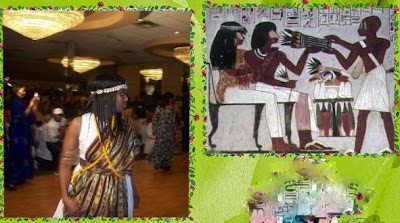You are using an out of date browser. It may not display this or other websites correctly.
You should upgrade or use an alternative browser.
You should upgrade or use an alternative browser.
The land of Punt was a Somali kingdom
- Thread starter Canuck
- Start date
- Status
- Not open for further replies.
View attachment 2567
https://en.wikipedia.org/wiki/Steatopygia
"Steatopygia would seem to have been a characteristic of a population which once extended from the Gulf of Aden to the Cape of Good Hope, from which peoples the Khoisan and Pygmies may be remnants.[citation needed] Among the Khoisan, it begins in infancy and is fully developed by the time of the first pregnancy. While the Khoisan afford the most noticeable examples of its development, it is by no means rare in other parts of Africa."
Queen Ati of Pwenet was Khoisan, or Bon.
Somalis did not reach the Red Sea coast until the first century AD. They conquered and enslaved the Bon , who became the Madhibaan and Midgan, in the 12th and 13th centuries.
Somalis are not the people of Pwenet.
http://www.madhibaan.org/
Queen Hadiyo Of punt name is still used in Somalia till today and it's meaning in our language hadiyo is guidance.View attachment 2567
https://en.wikipedia.org/wiki/Steatopygia
"Steatopygia would seem to have been a characteristic of a population which once extended from the Gulf of Aden to the Cape of Good Hope, from which peoples the Khoisan and Pygmies may be remnants.[citation needed] Among the Khoisan, it begins in infancy and is fully developed by the time of the first pregnancy. While the Khoisan afford the most noticeable examples of its development, it is by no means rare in other parts of Africa."
Queen Ati of Pwenet was Khoisan, or Bon.
Somalis did not reach the Red Sea coast until the first century AD. They conquered and enslaved the Bon , who became the Madhibaan and Midgan, in the 12th and 13th centuries.
Somalis are not the people of Pwenet.
http://www.madhibaan.org/
View attachment 2567
https://en.wikipedia.org/wiki/Steatopygia
"Steatopygia would seem to have been a characteristic of a population which once extended from the Gulf of Aden to the Cape of Good Hope, from which peoples the Khoisan and Pygmies may be remnants.[citation needed] Among the Khoisan, it begins in infancy and is fully developed by the time of the first pregnancy. While the Khoisan afford the most noticeable examples of its development, it is by no means rare in other parts of Africa."
Queen Ati of Pwenet was Khoisan, or Bon.
Somalis did not reach the Red Sea coast until the first century AD. They conquered and enslaved the Bon , who became the Madhibaan and Midgan, in the 12th and 13th centuries.
Somalis are not the people of Pwenet.
http://www.madhibaan.org/
Somli-Egyptian Headrests; to the right the Headread of Tutankhamun ,in the middle the Somali Cultural Headrest and to the left of this picture ,we have the Headrest of Nefertiti or Nafariithatii,"the good girl
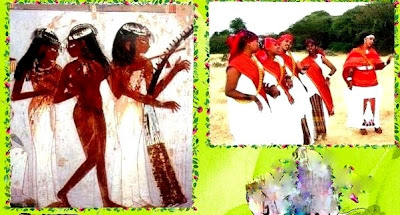
Cultural Comparison of Ancient-Egyptian-Somali People : To the left of this picture , Three Egyptian Musicians ,Pharaonic Women Artists and to the right, a Somali Woman Artist Sahra Ilays with her Traditional Folk Group . They wear a similar Egyptian cultural dress .The brown fabric of finery between their legs is called "dhacle" in Somali . You can observ and compare ,even ,the Egyptian Art was preserved in Somali Traditional Clothes . This preserved culture is called in Somali "Hidde" meaning the rest of ancient alive culture .
@Grant
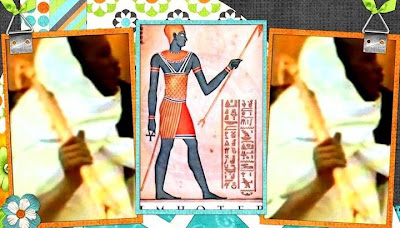
The Ancient Egyptian IMHOTEP (in the middle ) holding the same Somali Cultural Scepter called "HANGOOL" in Somali language and H-N-G-L in Ancient-Egyptian Hieroglyphical writing .The Somalis use still now ,traditionally this pharaonic Specific Scepter called Hangool which means the lion's ambition (Han (ambition )+Gool (lion) ) .Imhotep was alive in the 28th century (Egyptian ii-m-ḥtp*jā-im-ḥatāpmeaning "the one who comes in peace, is with peace"/ also the word "Imi" means "he comes" in somali language) was an Egyptian Polymath who served under the Third dynasty king Djoser as chancellor to the pharaoh and high priest of at Heliopolis . He is considered to be the father of medecine the first architect and engineer and physician in early history though two other good physicians, Hesy-Ra and Merit-Ptah lived around the same time. The full list of his titles is: Chancellor of the King of Egypt, Doctor, First in line after the King of Upper Egypt, Administrator of the Great Palace, Hereditary nobleman, High Priest of Heliopolis, Builder, Chief Carpenter, Chief Sculptor, and Maker of Vases in Chief.

The Ancient Egyptian IMHOTEP (in the middle ) holding the same Somali Cultural Scepter called "HANGOOL" in Somali language and H-N-G-L in Ancient-Egyptian Hieroglyphical writing .The Somalis use still now ,traditionally this pharaonic Specific Scepter called Hangool which means the lion's ambition (Han (ambition )+Gool (lion) ) .Imhotep was alive in the 28th century (Egyptian ii-m-ḥtp*jā-im-ḥatāpmeaning "the one who comes in peace, is with peace"/ also the word "Imi" means "he comes" in somali language) was an Egyptian Polymath who served under the Third dynasty king Djoser as chancellor to the pharaoh and high priest of at Heliopolis . He is considered to be the father of medecine the first architect and engineer and physician in early history though two other good physicians, Hesy-Ra and Merit-Ptah lived around the same time. The full list of his titles is: Chancellor of the King of Egypt, Doctor, First in line after the King of Upper Egypt, Administrator of the Great Palace, Hereditary nobleman, High Priest of Heliopolis, Builder, Chief Carpenter, Chief Sculptor, and Maker of Vases in Chief.
@Grant
Somali Egyptian-Puntite History :
"Encyclopædia Britannica describes Punt as follows: “in ancient Egyptian and Greek geography, the southern coast of the Red Sea and adjacent coasts of the Gulf of Aden, corresponding to modern coastal Eritrea, Somalia and Djibouti ."/ In “The Making of Egypt” (1939). Petrie states that the Land of Punt was “sacred to the Egyptians as the source of their race.”
« Again the representations of the early Puntites, or Somali people, on the Egyptian monuments, show striking resemblances to the Egyptians themselves. » By Brian Brown New York: Brentano's[1923]/ We can understand theses Similarities through their ancestral history :
According to the historian Richard Pankhurst :"The Egyptians sometimes called Punt land Ta-Netjeru, meaning "Land of the Gods," and considered it their place of origin ." (Richard Pankhurst, The Ethiopian Borderlands:1997)
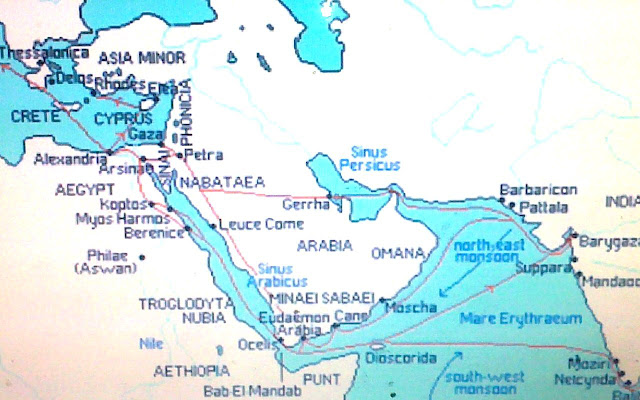
Map of the Antiquity , Ancient World .
"In addition to the erection and endowments of many temples listed in the Palermo Stone, the Pharaohs of the Fifth Dynasty were active, as the King Sahure (2458-2446 B.C.) from this Egyptian Old Kingdom, Dynasty V (2498-2491 B.C.). Egyptian ships also reached the shores of the land of Punt on the Somali coast to procure highly valued cargoes of myrrh, ebony and animals, among other goods. " Text Reference: The UNESCO General History of Africa:
Ancient Civilization of Africa, Vol, II, General History of Africa, G. Mokhtar, 1990, p 64-68
The greek historian Diodorus of Sicily in his book "Universal history "said that in 6th century before-J-Christ , because of the euro-asiatics invasions in Egypt , more than 200 thousands of Ancient-egyptians migrated in the south of the Nile in the direction of Ethiopia ,East Africa (Now,Sudan ,Ethiopia ,Somalia ,Djibouti..) ./ This last historical fact can explain why the somali language is a survived ancient-egyptian language ,according to the british linguist :"The language of ancient Egypt belonged to the Hamitic group;today, of course, the language of
Egypt is a form of Arabic, but a descendant of the ancient Hamitic
language of Egypt, Coptic, survived until about the fifteenth
century, and is still used as the liturgical language of the Coptic
Church.Surviving Hamitic languages are spoken across a large part of North Africa and include Somali." (The english language ,A Historical Introduction," by Charles Barber .)
Somali Egyptian-Puntite History :
"Encyclopædia Britannica describes Punt as follows: “in ancient Egyptian and Greek geography, the southern coast of the Red Sea and adjacent coasts of the Gulf of Aden, corresponding to modern coastal Eritrea, Somalia and Djibouti ."/ In “The Making of Egypt” (1939). Petrie states that the Land of Punt was “sacred to the Egyptians as the source of their race.”
« Again the representations of the early Puntites, or Somali people, on the Egyptian monuments, show striking resemblances to the Egyptians themselves. » By Brian Brown New York: Brentano's[1923]/ We can understand theses Similarities through their ancestral history :
According to the historian Richard Pankhurst :"The Egyptians sometimes called Punt land Ta-Netjeru, meaning "Land of the Gods," and considered it their place of origin ." (Richard Pankhurst, The Ethiopian Borderlands:1997)

Map of the Antiquity , Ancient World .
"In addition to the erection and endowments of many temples listed in the Palermo Stone, the Pharaohs of the Fifth Dynasty were active, as the King Sahure (2458-2446 B.C.) from this Egyptian Old Kingdom, Dynasty V (2498-2491 B.C.). Egyptian ships also reached the shores of the land of Punt on the Somali coast to procure highly valued cargoes of myrrh, ebony and animals, among other goods. " Text Reference: The UNESCO General History of Africa:
Ancient Civilization of Africa, Vol, II, General History of Africa, G. Mokhtar, 1990, p 64-68
The greek historian Diodorus of Sicily in his book "Universal history "said that in 6th century before-J-Christ , because of the euro-asiatics invasions in Egypt , more than 200 thousands of Ancient-egyptians migrated in the south of the Nile in the direction of Ethiopia ,East Africa (Now,Sudan ,Ethiopia ,Somalia ,Djibouti..) ./ This last historical fact can explain why the somali language is a survived ancient-egyptian language ,according to the british linguist :"The language of ancient Egypt belonged to the Hamitic group;today, of course, the language of
Egypt is a form of Arabic, but a descendant of the ancient Hamitic
language of Egypt, Coptic, survived until about the fifteenth
century, and is still used as the liturgical language of the Coptic
Church.Surviving Hamitic languages are spoken across a large part of North Africa and include Somali." (The english language ,A Historical Introduction," by Charles Barber .)
@Grant
Even, the recent genetic research prove that the Somali DNA is exactly appropriate to the Ancient-Egyptian DNA=> Haplogroup E1b1b1a (V68) :19th century before J-Christ => Place of origin : Egypt and northern Soudan . Extract of the genetic research More recently, Tillmar et al. (2009) typed 147 males from Somalia for 12 Y-STR loci, and observed that 77% (113/147) had typical E1b1b1a1b haplotypes. This is currently the highest frequency of E1b1b1a1b found in any single sample population. Similarly, Hassan et al. (2008) in their study observed this to be the most common of the sub-clades of E-M78 found in Sudan, especially among the Beja, Masalit and Fur. The Beja, like Somalis,Sahos,Afars and Oromos, speak an Afro-Asiatic language and live along the "corridor" from Egypt to the Horn of Africa.)
More recently, Tillmar et al. (2009) typed 147 males from Somalia for 12 Y-STR loci, and observed that 77% (113/147) had typical E1b1b1a1b haplotypes. This is currently the highest frequency of E1b1b1a1b found in any single sample population. Similarly, Hassan et al. (2008) in their study observed this to be the most common of the sub-clades of E-M78 found in Sudan, especially among the Beja, Masalit and Fur. The Beja, like Somalis,Sahos,Afars and Oromos, speak an Afro-Asiatic language and live along the "corridor" from Egypt to the Horn of Africa.)
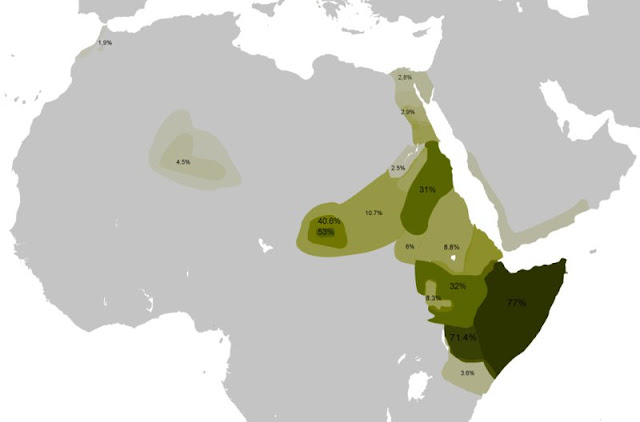
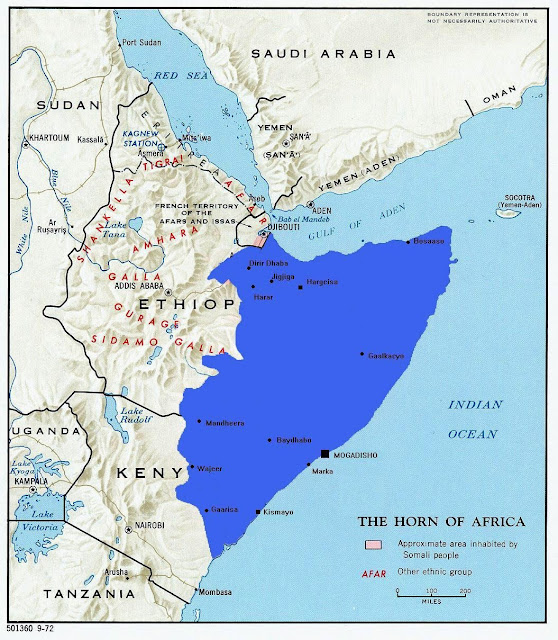
The Current Somali Territories after the colonial division in the 19th century A.D
Even, the recent genetic research prove that the Somali DNA is exactly appropriate to the Ancient-Egyptian DNA=> Haplogroup E1b1b1a (V68) :19th century before J-Christ => Place of origin : Egypt and northern Soudan . Extract of the genetic research


The Current Somali Territories after the colonial division in the 19th century A.D
Who the f*ck cares, is that going to raise my income, give me a xaax ting and a nice fooq? Land of Punt-kaaga was, wallahi this line became a mantra for these nacalads:
"Land of Punt was Somali"
..............? Ilaahaaga ka cabso.
We have their traditions in our culture and share similar words in our language. So who gives a shit if you don't care, learn your history brother forget football your shit at it.
@Grant
Comparison of Egyptian-Somali Vocabulary:
"The language of ancient Egypt belonged to the Hamitic group...Surviving Hamitic languages are spoken across a large part of North Africa and include Somali." (The english language ,A Historical Introduction," by the british historian and linguist Charles Barber .)
1) In ancient-egyptian language "Hes" = song,sing with musical instrument / in somali language :" Hees"= song,sing with musical instrument.
2) "AAR" means "Lion" in both languages .
3) "Usha" means "Scepter" in both languages .
4)In Somali-Egyptian" Shub" means a)"pour out , " b) construction made of concrete .
5) In Somali-Egyptian languages :"Sekedseked" means " Redoubling of the building blocks ,Stacked building blocks or something else .
6) In Egyptian-Somali :
Neter/Neder (divine being) Hipo/Hibo (it means "gift" and the sound "p"it is not mainly used in Hamitic languages ): Heru/Huur (a stork) : Tuf/Tuf (spit) : Habi (the Nile)/ Habi,ᵓAbi (source of water,to drink ,give him drink ) Wabi ( a river) ; Kab/kab (shoe) brq/biriq (lightning) :"Qbb/Qaboob (cold,cool,fresh ): 'ayah/dayah (moon) ; dab/dab (fire) anka/aniga (pronoun "I" ): su,asu/usi (he) ; Ka,Kaah /Ka,Kaah (Him,the man's appearance, spirit,vital essence,) ; Xi/Ki (a such ) ; Hati,Hat/Haat,Haati (widen wings,flying birds) ; medu/muud (liquid), Hoo/Hoo (to offer ) , Gundhate ,Gunti/Gundhate ,Gunti (loincloth) ,Maanta/Maanta (today,morning ); Kaua/Kaw (standard number one ,1,first ) ; NefNefi/NefNef,Neef (respiration,breath ), (Râ,Horakhty /Râh, Horrahthy (the Sun)
In Ancient-egyptian "Râ" is the sun-god / in Somali "Qor-Rah" means the "neck of Rah ,sun-god . ( Qor= neck / Rah: sun-god) the letter " a" is pronounced with the voiceless pharyngeal fricative
[ħ]
7) Egyptian Somali :Awoow /Awoow (grandfather,old man) ;
Ayeeytha/Ayeeyda (grandmother,old woman, old age )
8) In Ancient-egyptian "Hun, Hunnu" = young man ,young girl/ in Somali "Hun, Hunnu,Huunno" = young man , young girl .
9) Two Somali/Egyptian Similar Names of the Pharaonic Enthronement : Sare,Hore/Sare,Hore ( the High and the First )
10)In ancient-egyptian :Ausar =god Osiris ,ancestor of egyptians /.In Somali : Ausar,= Father Sar (AW-father ; Sar), Isir,Ausar = Ancestor , venerated in the Somali Culture in the antiquity according to a Somali Historian and linguist Diriye .
11) In Somali Language "The pyramids" means "Xabaal-Maguur" =" Stable Graves "
There are many similar words somali-egyptian ,preserved in Somali language. I just shared with you some examples above but you can find many others if you fond of the Egyptology and History .
References : "Egyptian Hieroglyphic Dictionary by Budge" ;
"Black Nations and Culture by Cheikh Anta Diop" ; "Learn Somali by Diriye Abdillahi "
Fiqi's Somali English Dictionary " by A.A Hashi 1985 .etc...
Comparison of Egyptian-Somali Vocabulary:
"The language of ancient Egypt belonged to the Hamitic group...Surviving Hamitic languages are spoken across a large part of North Africa and include Somali." (The english language ,A Historical Introduction," by the british historian and linguist Charles Barber .)
1) In ancient-egyptian language "Hes" = song,sing with musical instrument / in somali language :" Hees"= song,sing with musical instrument.
2) "AAR" means "Lion" in both languages .
3) "Usha" means "Scepter" in both languages .
4)In Somali-Egyptian" Shub" means a)"pour out , " b) construction made of concrete .
5) In Somali-Egyptian languages :"Sekedseked" means " Redoubling of the building blocks ,Stacked building blocks or something else .
6) In Egyptian-Somali :
Neter/Neder (divine being) Hipo/Hibo (it means "gift" and the sound "p"it is not mainly used in Hamitic languages ): Heru/Huur (a stork) : Tuf/Tuf (spit) : Habi (the Nile)/ Habi,ᵓAbi (source of water,to drink ,give him drink ) Wabi ( a river) ; Kab/kab (shoe) brq/biriq (lightning) :"Qbb/Qaboob (cold,cool,fresh ): 'ayah/dayah (moon) ; dab/dab (fire) anka/aniga (pronoun "I" ): su,asu/usi (he) ; Ka,Kaah /Ka,Kaah (Him,the man's appearance, spirit,vital essence,) ; Xi/Ki (a such ) ; Hati,Hat/Haat,Haati (widen wings,flying birds) ; medu/muud (liquid), Hoo/Hoo (to offer ) , Gundhate ,Gunti/Gundhate ,Gunti (loincloth) ,Maanta/Maanta (today,morning ); Kaua/Kaw (standard number one ,1,first ) ; NefNefi/NefNef,Neef (respiration,breath ), (Râ,Horakhty /Râh, Horrahthy (the Sun)
In Ancient-egyptian "Râ" is the sun-god / in Somali "Qor-Rah" means the "neck of Rah ,sun-god . ( Qor= neck / Rah: sun-god) the letter " a" is pronounced with the voiceless pharyngeal fricative
[ħ]
7) Egyptian Somali :Awoow /Awoow (grandfather,old man) ;
Ayeeytha/Ayeeyda (grandmother,old woman, old age )
8) In Ancient-egyptian "Hun, Hunnu" = young man ,young girl/ in Somali "Hun, Hunnu,Huunno" = young man , young girl .
9) Two Somali/Egyptian Similar Names of the Pharaonic Enthronement : Sare,Hore/Sare,Hore ( the High and the First )
10)In ancient-egyptian :Ausar =god Osiris ,ancestor of egyptians /.In Somali : Ausar,= Father Sar (AW-father ; Sar), Isir,Ausar = Ancestor , venerated in the Somali Culture in the antiquity according to a Somali Historian and linguist Diriye .
11) In Somali Language "The pyramids" means "Xabaal-Maguur" =" Stable Graves "
There are many similar words somali-egyptian ,preserved in Somali language. I just shared with you some examples above but you can find many others if you fond of the Egyptology and History .
References : "Egyptian Hieroglyphic Dictionary by Budge" ;
"Black Nations and Culture by Cheikh Anta Diop" ; "Learn Somali by Diriye Abdillahi "
Fiqi's Somali English Dictionary " by A.A Hashi 1985 .etc...
@Grant
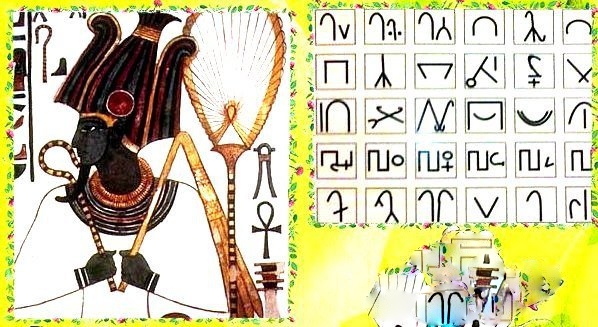
Praise to God ! The Ancient-Egyptian Hieroglyphical Writing and Symbols are still alive and kicking in 2012 A.D.“ Generally , The Somalis use the "Sumado" ,the hieroglyphic Symbols in their traditional and social way of life . As example ,here ,to the right of the picture of Osiris ,we have the Hieroglyphical Symbols of the Issas clans in East Africa . extracted from the book: "The Search for the Ugaas in the Xeer Tradition” by the Dr. Ali Moussa Iye.Chief of Intercultural Dialogue Section in Unesco .(1995-2000).The Somalis use still now culturally these hieroglyphical for the social regulation like the Ancient-egyptians pharaohs .The Issa tribe is a branch of the Somali People in the Horn of Africa .They live mainly in Djibouti , in Ethiopia,Diridhabe region and the North of Somalia ,in Zayla ,Lughaya and Awdal region . In ancient-Egyptian language "Sumado" means"write the hieroglyphs" and also in somali ,"Sumado" means "the Hieroglyphs" and you can observ these somali current hieroglyphs, to the right of the Pharaoh's Picture above .
Conclusion: Somalia is ,now, the Ancient land of Punt : Homeland of the Ancient-Egyptians . After ,the asiatics and europeans invasions in Ancient-Egypt , most of them came back and migrated to the south of the Nile , in the direction of the current Horn of Africa , Land of Punt ,Somali Peninsula .The road of frankincence and myrrh from Egypt to the Punt,"Pwenet " was not forgotten by the Ancient-Egyptians .The Somalis share also this common Ancient-Egyptian Past with their cousins in North-East Africa ,the Tutsis, the Oromos, the Afars, the Saho,the Beja, the Indigenous African Egyptians who live still now in Egypt etc...

Praise to God ! The Ancient-Egyptian Hieroglyphical Writing and Symbols are still alive and kicking in 2012 A.D.“ Generally , The Somalis use the "Sumado" ,the hieroglyphic Symbols in their traditional and social way of life . As example ,here ,to the right of the picture of Osiris ,we have the Hieroglyphical Symbols of the Issas clans in East Africa . extracted from the book: "The Search for the Ugaas in the Xeer Tradition” by the Dr. Ali Moussa Iye.Chief of Intercultural Dialogue Section in Unesco .(1995-2000).The Somalis use still now culturally these hieroglyphical for the social regulation like the Ancient-egyptians pharaohs .The Issa tribe is a branch of the Somali People in the Horn of Africa .They live mainly in Djibouti , in Ethiopia,Diridhabe region and the North of Somalia ,in Zayla ,Lughaya and Awdal region . In ancient-Egyptian language "Sumado" means"write the hieroglyphs" and also in somali ,"Sumado" means "the Hieroglyphs" and you can observ these somali current hieroglyphs, to the right of the Pharaoh's Picture above .
Conclusion: Somalia is ,now, the Ancient land of Punt : Homeland of the Ancient-Egyptians . After ,the asiatics and europeans invasions in Ancient-Egypt , most of them came back and migrated to the south of the Nile , in the direction of the current Horn of Africa , Land of Punt ,Somali Peninsula .The road of frankincence and myrrh from Egypt to the Punt,"Pwenet " was not forgotten by the Ancient-Egyptians .The Somalis share also this common Ancient-Egyptian Past with their cousins in North-East Africa ,the Tutsis, the Oromos, the Afars, the Saho,the Beja, the Indigenous African Egyptians who live still now in Egypt etc...
Zayd
Habar Magaadle
We have their traditions in our culture and share similar words in our language. So who gives a shit if you don't care, learn your history brother forget football your shit at it.
Warya, ana ku wasa, abaha ancient egyptkaaga was.
Wallahi hadu kan loo sheego inu aha ina fircoon, sidu u farxi la'a waad yaabi. Bila ilaah baad tahay warya.
@Grant

Praise to God ! The Ancient-Egyptian Hieroglyphical Writing and Symbols are still alive and kicking in 2012 A.D.“ Generally , The Somalis use the "Sumado" ,the hieroglyphic Symbols in their traditional and social way of life . As example ,here ,to the right of the picture of Osiris ,we have the Hieroglyphical Symbols of the Issas clans in East Africa . extracted from the book: "The Search for the Ugaas in the Xeer Tradition” by the Dr. Ali Moussa Iye.Chief of Intercultural Dialogue Section in Unesco .(1995-2000).The Somalis use still now culturally these hieroglyphical for the social regulation like the Ancient-egyptians pharaohs .The Issa tribe is a branch of the Somali People in the Horn of Africa .They live mainly in Djibouti , in Ethiopia,Diridhabe region and the North of Somalia ,in Zayla ,Lughaya and Awdal region . In ancient-Egyptian language "Sumado" means"write the hieroglyphs" and also in somali ,"Sumado" means "the Hieroglyphs" and you can observ these somali current hieroglyphs, to the right of the Pharaoh's Picture above .
Conclusion: Somalia is ,now, the Ancient land of Punt : Homeland of the Ancient-Egyptians . After ,the asiatics and europeans invasions in Ancient-Egypt , most of them came back and migrated to the south of the Nile , in the direction of the current Horn of Africa , Land of Punt ,Somali Peninsula .The road of frankincence and myrrh from Egypt to the Punt,"Pwenet " was not forgotten by the Ancient-Egyptians .The Somalis share also this common Ancient-Egyptian Past with their cousins in North-East Africa ,the Tutsis, the Oromos, the Afars, the Saho,the Beja, the Indigenous African Egyptians who live still now in Egypt etc...

Praise to God ! The Ancient-Egyptian Hieroglyphical Writing and Symbols are still alive and kicking in 2012 A.D.“ Generally , The Somalis use the "Sumado" ,the hieroglyphic Symbols in their traditional and social way of life . As example ,here ,to the right of the picture of Osiris ,we have the Hieroglyphical Symbols of the Issas clans in East Africa . extracted from the book: "The Search for the Ugaas in the Xeer Tradition” by the Dr. Ali Moussa Iye.Chief of Intercultural Dialogue Section in Unesco .(1995-2000).The Somalis use still now culturally these hieroglyphical for the social regulation like the Ancient-egyptians pharaohs .The Issa tribe is a branch of the Somali People in the Horn of Africa .They live mainly in Djibouti , in Ethiopia,Diridhabe region and the North of Somalia ,in Zayla ,Lughaya and Awdal region . In ancient-Egyptian language "Sumado" means"write the hieroglyphs" and also in somali ,"Sumado" means "the Hieroglyphs" and you can observ these somali current hieroglyphs, to the right of the Pharaoh's Picture above .
Conclusion: Somalia is ,now, the Ancient land of Punt : Homeland of the Ancient-Egyptians . After ,the asiatics and europeans invasions in Ancient-Egypt , most of them came back and migrated to the south of the Nile , in the direction of the current Horn of Africa , Land of Punt ,Somali Peninsula .The road of frankincence and myrrh from Egypt to the Punt,"Pwenet " was not forgotten by the Ancient-Egyptians .The Somalis share also this common Ancient-Egyptian Past with their cousins in North-East Africa ,the Tutsis, the Oromos, the Afars, the Saho,the Beja, the Indigenous African Egyptians who live still now in Egypt etc...
Warya, ana ku wasa, abaha ancient egyptkaaga was.
Wallahi hadu kan loo sheego inu aha ina fircoon, sidu u farxi la'a waad yaabi. Bila ilaah baad tahay warya.
Do you know 18 Dynasty was the most famous Prophet Yusuf was sent tutankhamun father I'm not sure but the Prophet Yusuf was born in that Era. And Queen Hatshepsut was the one, who discovered and re linked with the Land of Punt.
Prophet Yusuf (Joseph) - English dubbed TV series.
- Status
- Not open for further replies.

